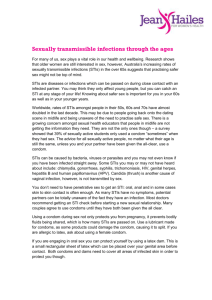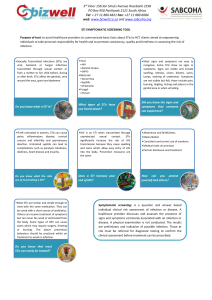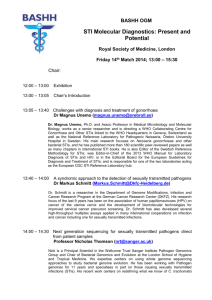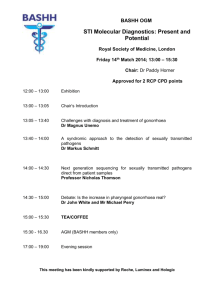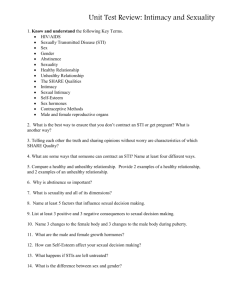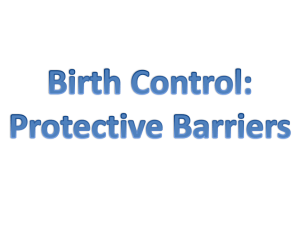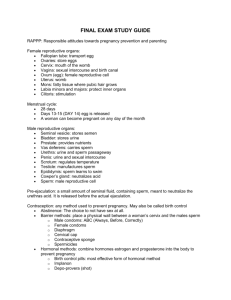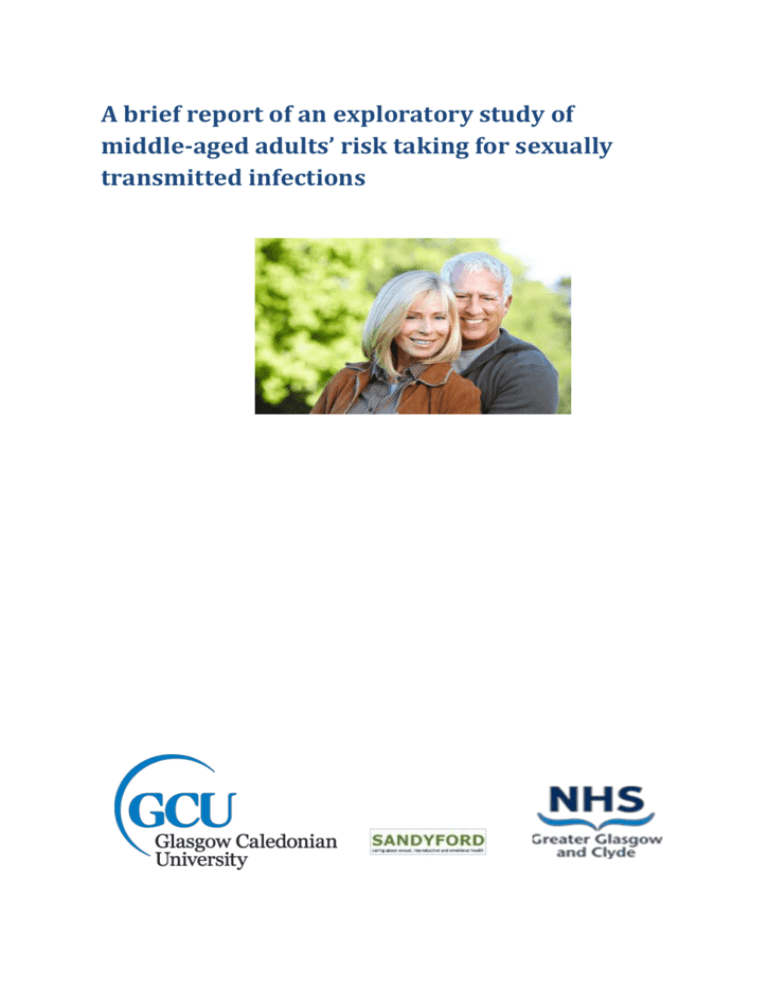
A brief report of an exploratory study of
middle-aged adults’ risk taking for sexually
transmitted infections
An exploration of middle-aged
adults’ risk taking for sexually
transmitted infections (STIs)
Background
The rates of STIs are rising among adults aged
over forty-five in the UK1,2. This rise is taking
place against a backdrop of midlife social changes
compared to previous generations, particularly
where new sexual partners are sought following
bereavement, divorce or separation3. At the same
time, adults in the UK are expected to stay
healthier4 and to live longer5. As good health is
linked with increased sexual activity6, it is likely
that STIs within this age group will continue to
rise. There is very little knowledge of how adults
aged over 45 manage risks for STIs. As a result,
there is limited evidence on which to build health
promotion interventions targeted at this age
group. This paper reports on a project exploring
how middle-aged adults approached risk for STIs
in new sexual relationships.
The study
The project aimed to:
Identify factors influencing middle-aged
adults’ risk taking for STIs.
Understand out how middle-aged adults
manage their sexual lives in the light of STI
risk.
Establish what middle-aged adults know
and how they feel about STIs.
One to one interviews took place with thirty-one
heterosexual men and women aged between
forty-five and sixty-five recruited from NHS sexual
health clinics and community sport and leisure
facilities.
Key points
Both men and women prioritised love and
trust in relationships, which was viewed as
a guard against STI risk. STIs were linked
with causal sex and often seen as irrelevant
to their lives.
Older was expected to be wiser, resulting
in self-blame and barriers to seeking help
for STI care when things went wrong. Risk
behaviour was associated with being
young.
Transitioning following bereavement,
divorce and separation were experienced
as risky periods for acquiring an STI.
Pregnancy continued to be seen as the
main unwanted outcome of unprotected
sex.
Risk assessments for STIs could be
complex, and included sexual histories and
partner attributes.
STI testing before sex divided opinions.
Condoms were often linked with reduced
pleasure and intimacy.
Middle-aged adults had STIs related
knowledge but lacked confidence in what
they knew. People knew most about HIV,
linking it with risk groups.
STIs were stigmatized. Those who had
recently attended sexual health clinics felt
more at risk for STIs.
What does this research add to what
we know?
This study was small scale, limiting its applicability
to the wider population. It supports existing
evidence suggesting that midlife relationship
transitions create STI-related risks for both
men and women. The study adds to existing
research among young people suggesting that
STIs are stigmatized across the life course. The
inclusion of men in this study suggests that
adults of both genders prioritise intimacy over
concerns about STI risk at all stages of the life
course.
Findings
Intimate relationships as safe from STIs
Intimate relationships, based on love and trust,
were mainly viewed as safe from STIs. Reliance
on love and trust in each new relationship
reduced concerns about transferring STIs from
one partner to the next. STIs were associated
with casual sex, and often seen as not relevant to
older adults’ lives.
Sex as age appropriate
Middle-aged adults tended to view young people
as sexually irresponsible and more at risk for STIs.
Being older was associated with an expectation of
increased maturity, resulting in self-blame and
barriers to seeking STI care when things went wrong.
first and foremost I felt dirty, I felt a woman
of my age, why have you let this happen?
Margaret
Transitions as a risk for STIs
Periods of emotional upset after relationship
disruption, following bereavement, divorce or
separation were often experienced as times of
increased risk-taking for STIs.
you’ve been with somebody for twenty-one
years and then you’re suddenly you’re with
somebody new and you’re an old man ….so
sexual diseases is at the back of the list. Sam
Even transitions free of emotional trauma held
risks for STIs as middle-aged adults reconnected
sexually with their own youth.
yes it’s like living your childhood again I went
wild for a wee while you know .Janice
Pregnancy as the main risk from sex
Both men and women had worried about and
experienced unplanned pregnancies when they
were younger which for some had had farreaching consequences. For several women and
men, condoms had been used to avoid pregnancy
in the past; over half of all the women in the
study had associated condoms with birth control
rather than as protection against STIs. For most of
them, condoms had been replaced by other
methods of birth control when younger and were
no longer used at all. Most adults saw pregnancy as
the only negative outcome of sex, therefore in the
absence of pregnancy risk, STIs were not considered.
you should be able to just say ‘right I think
we should use a condom ‘…but....
sometimes when you get carried away you
end up you don’t, but.., I don’t tend to dwell
on it … because I know that years ago when
you are …of a reproductive age you would
think really twice but when you know that
the consequences aren’t going to be a baby,
maybe you don’t think so hard about it.
Gillian
Taking risks for STIs
Most adults made a risk assessment before having
recent unprotected sex with a new partner. Risk was
not necessarily addressed in a deliberate way but
reassurance came from other aspects of the
relationship.
when you meet somebody, you can feel, its
difficult to explain, you feel you’re
comfortable with this person so you don’t feel
you need to think about anything, but it
didn’t’ enter my head to discuss anything to
do with sexually transmitted diseases or
anything at all, cos anything that’s in the past
is in the past and it never entered my head.
Rory
Decisions to proceed with unprotected sex could
be complex, involving a mixture of feeling
comfortable with a partner, prioritising emotional
needs and ‘getting carried away’, sometimes with
alcohol described as a contributing factor. For
some men, finding women respectable reduced
their concerns about STI risk. Risk assessments
were generally based on information about a
partner’s sexual past and their character, with
feelings of love and trust prioritised.
Risk reducing technologies
Technologies aimed at reducing risk for STIs such
as testing before sex and condoms were not
often used. Adults generally lacked experience of
testing for STIs at the start of relationships.
Opinions about STI testing were divided; while
approved by some, others felt it demonstrated a
lack of trust. Condoms were often associated
with reduced pleasure, lack of trust, and casual
sex. A few men and women had started using
condoms when young often in response to events
such as STI diagnosis, pregnancy or raised awareness
about HIV and had continued to use condoms
regularly as older adults.
I’ve certainly learned by my mistake. And,
…yes it has changed the way I think about
them.[condoms] I’ve very conscious of
making sure I’ve always got plenty. You
never know when you’re going to have sex.
Amanda
Knowledge and feelings about STIs
Most adults knew about the symptoms, impact or
treatment for most of the common STIs, although
many were not confident in their knowledge.
Several adults had expected symptoms to signal
an STI, despite many common STIs having vague
or no symptoms7. HIV had the most impact on
STI-related knowledge of most adults;
perceptions of ‘at-risk groups’, tended to
reinforce earlier stigmas and allow adults to
distance themselves from feeling at risk. Adults
recruited from the NHS sexual health clinics
appeared to have increased their knowledge over
their life course. Some, but not all, attributed this
change to having attended the clinic or having
been diagnosed with an STI. Those who had
recently visited sexual health clinics often felt
more at risk for STIs.
(All names used are pseudonyms)
Research and policy implications
Targeting adults of all ages in transition from relationships, would aim to reduce STI risk at a time of
vulnerability. Further focussed research would probe the sources of stigma for middle-aged adults
around STIs in order to develop interventions to support increased use of risk avoiding technologies.
Clinical care providers could be supported in destigmatising discussions around sexual health issues
among older adults, extending the scope to include risk reduction with new partners.
References
1. HEALTH PROTECTION SCOTLAND. 2015. Genital herpes simplex, genital chlamydia and gonorrhoea
infection in Scotland: laboratory diagnoses 2005 - 2014 (HPS e-weekly report 16th June 2015),
(online), HPS, Glasgow.
2. PUBLIC HEALTH ENGLAND. 2015. Table 8: Selected STI diagnoses and rates in the UK by gender and
age group 2009-2013 (online) PHE
3. DEMEY, D., BERRINGTON, A., EVANDROU, M. & FALKINGHAM, J. 2011. The changing demography
of mid-life, from the 1980s to the 2000s, in Population Trends 145, pp. 16-34 (online), Office for
National Statistics.
4. OFFICE FOR NATIONAL STATISTICS. 2012a. Health expectancies at birth and at age 65 in the United
Kingdom, 2008-2010. Statistical bulletin. Released 29th Aug 2012 (online).
5. OFFICE FOR NATIONAL STATISTICS. 2014a. National life tables, United Kingdom, 2011-2013.
Released 25th September 2014 (online).
6. FIELD, N., MERCER, C. H., SONNENBERG, P., TANTON, C., CLIFTON, S., MITCHELL, K. R., ERENS, B.,
MACDOWALL, W., WU, F. & DATTA, J. 2013. Associations between health and sexual lifestyles in
Britain: findings from the third National Survey of Sexual Attitudes and Lifestyles (NATSAL-3). The
Lancet, Vol. 382, no. 9907, pp. 1830-1844.
7. WORLD HEALTH ORGANIZATION. 2007. Global strategy for the protection and control of sexually
transmitted infection 2006-2015: breaking the chain of transmission (online),WHO, Geneva.
Authors and acknowledgements
Thanks to the 31 men and women who generously gave up their time and shared their thoughts and
experiences and without whom this research would not have been possible. This briefing paper was
written by Jenny Dalrymple (Jenny.Dalrymple@gcu.ac.uk). It is based on the findings of her PhD,
undertaken at Glasgow Caledonian University and completed in September 2015.It was edited by Dr
Karen Lorimer at Glasgow Caledonian University.
Contact: jenny.dalrymple@gcu.ac.uk

